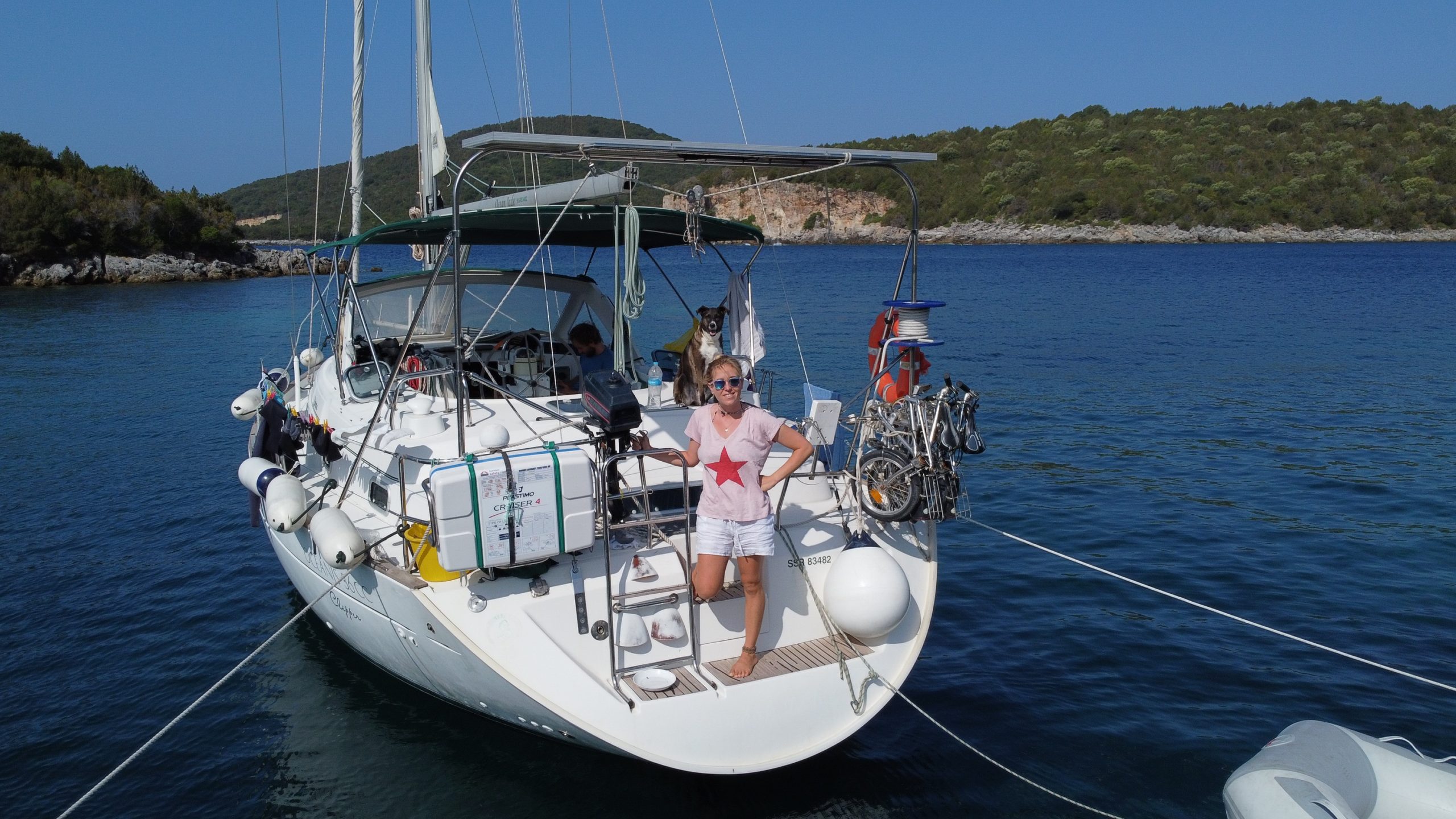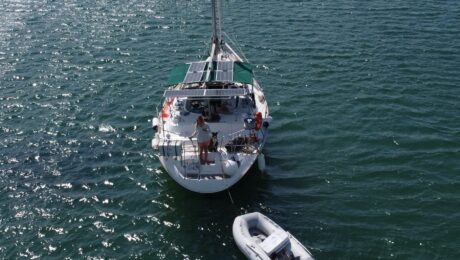With the spare time, we had in Israel before our move to Greece we worked like psychos. As I said before, the yacht was a bit over our budget, and we knew there would be more expenses that will come with actually putting the boat in the water.
Tomer worked like a donkey (apologies to all donkeys) building wooden pergolas, heavy lifting all day, while I worked as a Skipper. I also taught a course in the Marine School during our last week in the country. We packed five suitcases and one giant box, and basically, our new life mostly consisted of surfing equipment, snorkeling gear, lots and lots of tools, tahini, black coffee, and very few clothes (sorry, frustrates me every time!)
This time we left our dog, Kiddo (whom you’ll be hearing a lot about), behind. We would come back for her after about a month and a half. I’ll elaborate more on the topic of taking a dog abroad and adjusting them to life on a yacht in a later post.
The week before our departure we were still handling last-minute arrangements, buying medicine, routine medical checks, and lots and lots of goodbyes. It was happy, and emotional, but also a little sad.
And there we were at the airport, packed up and ready to set out on a new and exciting adventure.
The way there went almost too smoothly - all of our concerns about what might happen, like the car rental company causing problems because we have too much equipment, or all the bags and boxes simply not fitting in the car, but everything went perfectly fine. What we did was I waited at the airport with all the stuff, and Tomer went to pick up the car (they upgraded us to a jeep and we felt like we had won the lottery) and came back to get me.
We got to the boat and it was super exciting!
We had a lot of work to do. Just to get a grip on the timetable, we got to Greece in June and didn’t want to miss the summer, so we tried to get our yacht into the water as quickly as possible, which meant first having to finish all the crucial functions we need for sailing (such as tending to the fuel tank and the engine, antifouling paint and more), and the less urgent matters to continue once we were already in the water.
So it started. We worked vibrantly. Our daily schedule would look something like this: waking up every day at 7:30 AM (except for the first day where Tomer got up at 5:00 AM because he couldn’t wait to start working), and every once in a while going to the shop to pick up missing parts, and working until the late hours of the night. At some point, we would stop working and start watching videos teaching us how to do the work that needed to be done the next day.
An important part of our day was garbage collecting - we had learned that the junkyard of the Cleopatra shipyard was a gold mine! Yachtsmen who don’t have time, patience, or the ability (or maybe just have a lot of money) tend to throw away things in almost perfect condition, which to us were treasures. Amongst the findings: a perfectly good dingy, a paddleboard, a foldable bike, and more.
Some of the work we did in the two weeks we worked on land was:
- Antifouling paint (barnacles): The process started off with scraping the entire body of the boat. Afterward, washing everything with soap, and then painted with a layer of Primer (two layers on the spots where there was no base paint). When it dried up we started painting with the Antifouling paint. We put two layers total on the body of the boat, and another third layer on the rudder and the waterline, since those are the spots that tend to get the most barnacles.
- Engine treatment: We weren’t sure how long the boat was on land and out of use but we assumed it was around two years. Many of our friends warned us of something called “diesel bug” - germs that form around the fuel tank when it isn’t used for a long time. In order to be on the safe side, we decided to do a massive cleansing of the whole system. Once we realized it was almost impossible to clean the tank as long as it was inside the boat, we decided to take it out entirely, properly clean it, and put it back. Only when we took it apart did we realize it was in fact full of diesel bugs. More treatments we did were changing the fuel filter (primary and secondary), oil filter, and impeller.
- Electricity system: Our ultimate goal was to be completely independent in terms of electricity, without the need for a generator, using shore power, or needing to turn on the engine in order to charge the batteries. We wanted to be able to live solely on renewable energy (at first it would be based only on the sun, but we were hoping to later be using wind as well). In order for that to work, we first needed to check what we already had on the boat, and if it was all working. For starters, we didn’t know whether the batteries installed on the boat were usable. So we charged them and quickly realized they weren’t usable. In addition to that, there was no 220V converter, which was necessary for us (mostly charging computers and other appliances).
At this stage, we realized that we would need to rebuild the entire system from scratch. After doing a lot of online studying, a bit of previous experience from building the electrical system in our caravan, and consulting with our friends, we came to a decision: we ordered three AGM batteries, every 110 amperes, and we bought a solar monitor of 50 amperes, voltage converter to 220 (all this designed specifically to support our Ninja shaker - how else are we supposed to make hummus?) and a monitor (a device which measures how much voltage is going into the battery and how much is coming out so that you can tell what the condition of the batteries is, as well as controlling the charging of the batteries using the boat engine).
All parts are from Victron Energy. They are very user-friendly and show you all the charging data and voltage usage live on your phone. Looking back this was a very smart decision. It serves us even today in analyzing the efficiency of our system, which parts take up the most or the least energy and when which is crucial since it really is all the power we have on our yacht.
On top of that, while we are sailing all of the navigation devices are based on our electricity system. Last but not at all least - four flexible solar panels of 100 watts each. The reason we chose flexible panels is simple: We knew we needed a lot of them in order to support the system we built, and that it’s a heavy business. Literally. And we didn’t even have a solar bridge yet. We decided to put the panels on the Bimini (the shadow above the cockpit). The Bimini isn’t very strong and so our only option for that amount of panels is the flexible ones (light and cheap by the way), with a plan to upgrade later and add panels that we would build on the bridge.
And so the days went by, we were studying a great deal, working hard, and mostly just loving every minute. In the midst of all the work, we even decided to take a little break, and we went surfing in Lefkada.
It was awesome.


